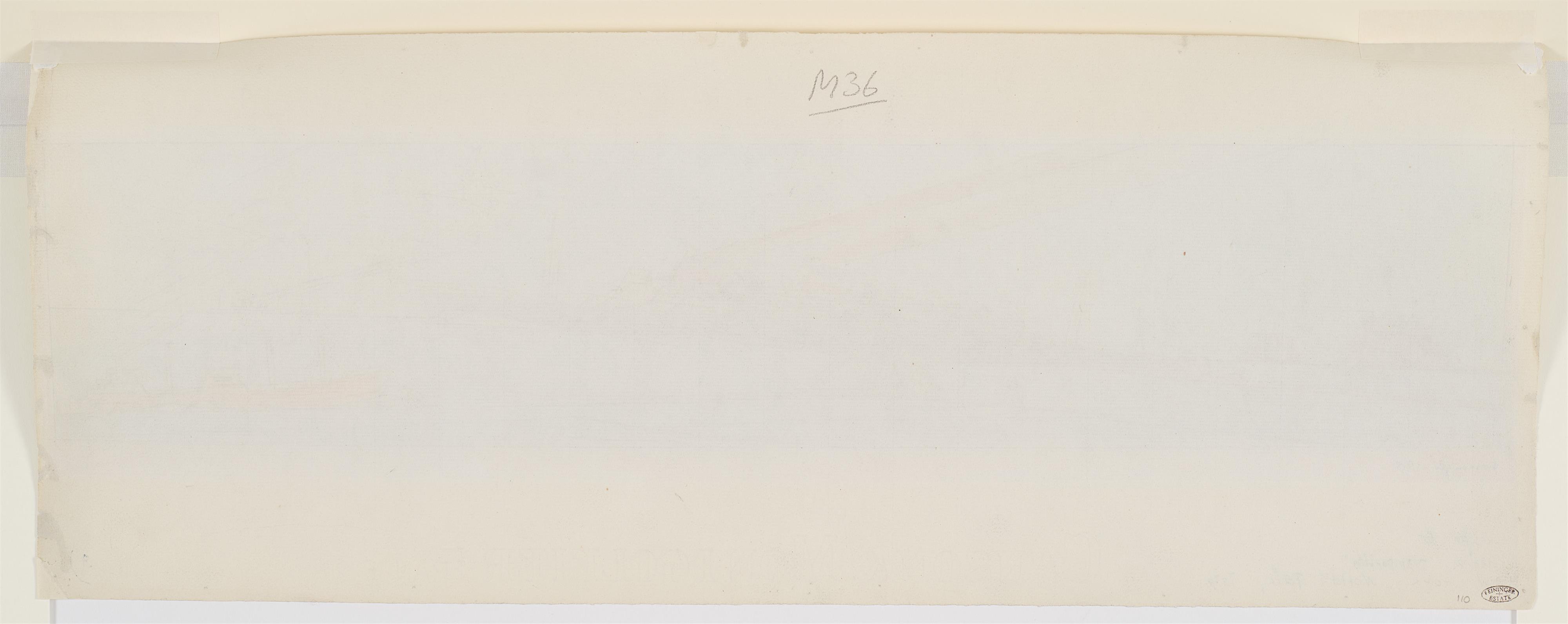Lyonel Feininger
Sketch for Mural (Marine Transportation Building, New York World's Fair)
1938
Watercolour, charcoal and pen and India ink on ivory-coloured laid paper with watermark "Canson & Montgolfier France" (cropped). 18.3 x 62.7 cm. Framed under glass. Signed and dated 'Feininger 1938' in black lower left. Inscribed below in pencil by an unknown hand "Sketch for Mural". With oval estate stamp "Feininger Estate" verso (not in Lugt), numbered in pencil "119" and inscribed "M39". - Slightly browned in the margins, otherwise in very good condition.
In June 1937, after more than 50 years in Europe, Lyonel Feininger returned back to New York with his wife Julia. The massive limitations on his work as an artist and also the Jewish ancestry of his wife had led to this decision. In every respect it was a new beginning for Feininger. Besides the fact that his hometown had become foreign to him, he was also initially almost unknown as an artist in the US and had to adjust to a different class of customers as well as altered interests on the part of museums. He got by during this initial period through teaching at California’s Mills College in the summer of 1937 and relying on the contacts of his German-American agent Emmy (Galka) Scheyer, who was able to sell several of his paintings. However, it was William R. Valentiner who provided him with his decisive start in his new surroundings: this art historian, whom he knew from Berlin, was now the director of the Detroit Museum of Art. In 1938 he arranged for Feininger to receive the commission to create a mural on the facade of the “Marine Transportation Building”, which was to be built and artistically decorated in connection with the 1939 World’s Fair. Feininger’s creation of three other pictures for the “Masterpieces of Art Building” was also organised by Valentiner.
These buildings and their artistic decoration represented measures taken by the American government as part of the “New Deal” to reduce unemployment and enable artists to survive in the midst of the Great Depression. The goal of the “Federal Art Project” was also to initiate a dialogue between art and the general public. For this reason, specific themes and a narrative, realistic depiction were favoured for the murals.
After barely painting during the first year of his American period, Feininger was overjoyed to accept the commission for these murals. The project also suited him well with respect to the desire for maritime motifs. He designed the emphatically horizontal watercolours “Dreimaster auf See” and “Passagierdampfer mit Windrose” for the low, but broad building. In both panoramas, Feininger has adapted his repertoire of ship models to an unusual format. The study of the three-masted barque shows a massive sailing ship surging up on a wave above a darkly shimmering sea and driven forward by signal-like streaks of red light. The many diagonal lines drawn in pen and ink serve to counter the dominant horizontal shapes. The second watercolour is centred around a steam-powered passenger ship, which is framed by fishing cutters and smaller sailing ships. The slightly oblique positioning of the hull and the diagonal lines of smoke coming from the steamer dynamise the watercolour done in various shades of blue. The pavilions were either torn down or fell into disrepair after the World’s Fair ended, with the result that the artist’s largest works became lost except for their design sketches; thus, these two watercolours hold a special value for lovers of Feininger’s work.
Certificate
Achim Moeller, director of the Lyonel Feininger Project LLC, New York – Berlin, has confirmed the authenticity of this work, which is registered with the Lyonel Feininger Project under the no. 1833-02-10-23. Certificate enclosed.
Provenance
Marlborough Fine Art, London, 1996 (label on the backing card); Collection Walter Brune, Düsseldorf






